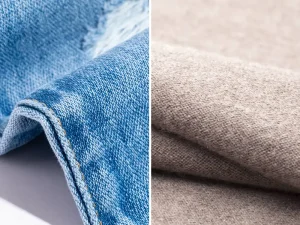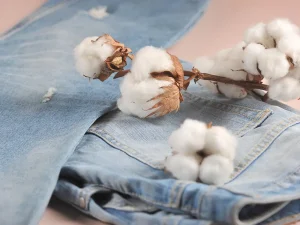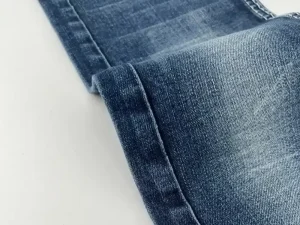Modetrends beeinflussen die Bekleidungsindustrie, da die Menschen nach einzigartigen Stilen suchen, um ihr Erscheinungsbild zu verbessern. Denim- und Baumwollstoffe haben jedoch schon immer fast jeden Modetrend dominiert. Sowohl Denim als auch Baumwolle haben denselben Hauptbestandteil, nämlich Baumwolle, und unterscheiden sich dennoch. Diese Unterschiede entfachen eine Debatte über Denim und Baumwolle.
Manche Leute glauben, dass Denim ein hochwertigerer Stoff für alle Jahreszeiten ist. Andere wiederum sind der Meinung, dass Baumwolle der beste Stoff überhaupt ist. Eine solche Meinungsverschiedenheit kann verwirrend sein, vor allem, wenn man sich zwischen diesen beiden Stoffen entscheiden muss. Aber keine Sorge, in diesem Artikel werden diese beiden Stoffe miteinander verglichen. Letzten Endes ist entweder Denim oder Baumwolle die beste Wahl für Sie. Fangen wir also an!
Überblick über Denim- und Baumwollstoffe

Baumwoll- und Denim-Stoffe bestehen aus natürlichen Fasern der Baumwollpflanze. Baumwollgewebe ist jedoch leicht, atmungsaktiv und wird in Leinwandbindung hergestellt. Denim hingegen ist haltbar, dicht und wird in Köperbindung hergestellt. Beide Stoffe haben ihre eigenen Eigenschaften, die sie für unterschiedliche Wetterbedingungen geeignet machen.
Interessanterweise bestehen diese beiden Stoffe aus Baumwolle (Naturfasern). Diese Fasern werden aus den Samen der Baumwollpflanze gewonnen oder gewonnen werden. Einige Denim- und Baumwollstoffe bestehen aus 100%-Baumwolle und enthalten keine synthetischen Materialien. Solche Stoffe sind im Allgemeinen teuer und gelten als hochwertig.
Moderne Hersteller fügen einige synthetische Fasern wie Spandex und Polyester hinzu. Diese synthetischen Fasern erhöhen die Haltbarkeit dieser Stoffe. Denken Sie daran, dass reine Baumwollfasern leicht und außergewöhnlich angenehm zu tragen sind. Ihre Haltbarkeit ist jedoch fraglich, so dass sie für den rauen Gebrauch nicht geeignet ist.
Baumwollgewebe werden schon seit mehreren Jahrhunderten verwendet. Die Baumwollpflanze ist seit vielen Jahrhunderten ein wichtiger Bestandteil der Agrarlandschaft. Die Menschen verwenden die Fasern der Baumwollpflanze und deren Gewebe zur Herstellung von Stoffen. Denim, eine Unterart des Baumwollstoffs, ist jedoch relativ neu. Er wurde erstmals im 17. Jahrhundert in Frankreich entwickelt.
Zeitweise war es von keiner nennenswerten Bedeutung und wurde nur von Arbeitern benutzt. Der Grund dafür ist, dass sie sehr haltbar und widerstandsfähig gegen Abnutzung und Verschleiß war. Jacob Davis war der erste Schneider, der 1873 Hosen aus Denim herstellte. Das war ein Anfang, und Denim ist bis heute sehr beliebt. Zur Erinnerung: Jeans- und Baumwollstoffe bestehen aus Garn, das aus den Fasern von Baumwollpflanzen gewonnen wird. Der Unterschied liegt darin, wie sie hergestellt werden.
Was sind die Unterschiede zwischen Baumwoll- und Denim-Stoffen?
Wie ich schon sagte, sind Baumwolle und Denim in ihren Hauptbestandteilen gleich. Sie werden jedoch in unterschiedlichen Verfahren hergestellt. Dieser Produktionsprozess führt zu Unterschieden zwischen diesen beiden Stoffen. Lassen Sie uns eintauchen und die Debatte über Baumwoll- und Denim-Stoffe im Detail diskutieren.
1- Produktionsprozess
Der wesentliche Unterschied zwischen Denim und Baumwolle liegt in ihrem Herstellungsverfahren. Baumwollgewebe ist relativ einfach zu produzieren. Dazu wird das Rohmaterial (Baumwollfasern) zu Garn gesponnen. Diese Garne werden dann zu Baumwollstoffen verwebt. Dieses Verfahren ist einfach und wird schon seit Jahrhunderten angewandt. Der Webprozess wird durch Maschinen gesteuert.
Die Produktionsprozess von Denim ist komplex und erfordert mehr Liebe zum Detail. Auch hier werden Baumwollfasern zur Herstellung von Garn verwendet. Im Gegensatz zu Baumwolle werden diese Garne in Köperbindung und nicht in einfacher oder glatter Bindung gewebt. Die Schuss- und Kettfäden erzeugen bei dieser Köperbindung diagonale Strukturen und Muster.
Nach dem Weben wird Denim einem zusätzlichen Färbeprozess unterzogen. Bei diesem Verfahren wird Indigo verwendet, das dem Stoff eine bestimmte Farbe verleiht. Die Farbe ist auf der Außenseite stärker ausgeprägt, während das Innere des Denims farblos bleibt. Baumwolle wird im Allgemeinen nicht zusätzlich gefärbt oder gefärbt.
2- Gewicht und Gefühl

Baumwollgewebe ist im Allgemeinen sehr leicht und angenehm zu tragen. Denken Sie daran, dass Baumwollfasern sehr glatt sind, so dass die daraus hergestellten Stoffe sehr atmungsaktiv sind. Deshalb werden Baumwollstoffe bei heißem Wetter oder im Sommer bevorzugt. Der Grund dafür ist, dass sie luftdurchlässig sind, was bei hohen Temperaturen ein gutes Gefühl ist.
Der Denim-Stoff ist jedoch dicker und besser für kaltes Wetter geeignet. Warum ist das Gewicht von Jeans- und Baumwollstoff unterschiedlich, obwohl beide aus denselben Baumwollfasern bestehen? Der Grund für diesen Unterschied liegt im Webverfahren. Bei Denim ist das Baumwollgarn in Köperbindung gewebt, was bedeutet, dass Schuss und Umwicklung eine dichtere Struktur ergeben.
Aufgrund dieser höheren Fadendichte sind Denim-Stoffe schwerer. Außerdem ist Denim luftundurchlässig, weshalb man ihn für kaltes Wetter oder den Winter als geeignet ansieht. Baumwollgewebe hat dank der einfachen Webart keine viel höhere Fadendichte. Er ist daher leicht und fühlt sich luftig und bequem an.
3- Dehnung und Beweglichkeit
Baumwolle ist ein nicht dehnbares Material, und die daraus hergestellten Stoffe sind nicht dehnbar. Im Allgemeinen sind sowohl Baumwolle als auch Denim nicht dehnbar und haben eine begrenzte Flexibilität. Moderne Hersteller fügen jedoch bei der Herstellung von Denim-Stoffen Elastan (Spandex) hinzu. Dies verleiht den Jeansstoffen eine gewisse Dehnbarkeit.
Denken Sie daran, dass die Hersteller Denim-Stoffe in verschiedenen Ausführungen verkaufen. Wenn Sie Flexibilität lieben, können Sie dehnbaren Denim kaufen. Diese Jeans bestehen aus einem Gemisch aus Baumwolle und Elastan (Spandex). Ihr Preis ist ebenfalls höher. Baumwollstoffe sind nicht elastisch und flexibel, weshalb sie leichter einlaufen können.
4- Erscheinungsbild und Ausblick

Das Baumwollgewebe ist glatt, einfarbig und in verschiedenen Farben erhältlich. Seine Glätte verleiht ihm ein elegantes Aussehen und Stil. Allerdings ist dieser Stoff anfällig für Falten und muss häufiger gebügelt werden. Interessanterweise sehen diese Falten auf Baumwollstoffen nicht schlecht aus. Im Gegenteil, die Menschen lieben Baumwolle wegen ihrer Falten.
Andererseits hat der Denim ein ausgeprägtes Erscheinungsbild und eine mutige Ausstrahlung. Er ist nicht glatt, sondern besteht aus rauen, diagonalen Linien. Bei Berührung fühlt sich dieser Stoff dichter und rauer an. Außerdem ist sein Äußeres in der Regel bunt, während sein Inneres farblos bleibt. Die beliebtesten Farben bei Jeansstoffen sind Blau und Schwarz.
5- Langlebigkeit und Dauerhaftigkeit
Baumwollfasern sind weich und zart und machen Baumwollgewebe angenehm zu tragen. Ihre Weichheit ist jedoch ein Nachteil, wenn es um die Haltbarkeit geht. Baumwollstoffe sind verschleißanfällig, daher müssen Sie beim Tragen von Baumwollhemden oder -kleidern vorsichtig sein.
Es kann leicht reißen, wenn man grob vorgeht. Andererseits ist Denim ein sehr haltbarer Stoff. Er zeigt keine Abnutzung, selbst wenn man ihn grob benutzt. Der Grund dafür ist, dass die Fadendichte höher ist, was ihn dicht und dick macht. Erinnern Sie sich daran, dass die Arbeiter Denim zuerst wegen seiner Stärke und Haltbarkeit verwendeten.
6- Wartung und Pflege
Baumwollstoffe brauchen keine Pflege. Der Grund dafür ist, dass ihre Farbe nicht verblasst und sie lange Zeit in guter Form bleiben. Allerdings bekommen diese Stoffe schnell Falten, die man durch Bügeln beheben kann. Beim Waschen und Trocknen brauchen sie keine besondere Pflege. Man kann sie mit normalem Wasser waschen und überall trocknen.
Andererseits ist Denim-Stoff sehr empfindlich. Wenn Sie ihn unvorsichtig waschen, kann seine Farbe verblassen. Außerdem muss er mit kaltem Wasser gewaschen werden. Heißes Wasser kann die Fäden schwächen; warmes Wasser kann sogar die Farbe beeinträchtigen. Auch das Trocknen in der Maschine ist nicht zu empfehlen. Sie müssen sie im Freien an der Sonne trocknen.
7- Kosten und Erschwinglichkeit
Baumwollgewebe sind relativ leicht zu produzieren. Sie sind einfach zu weben und erfordern keine hochentwickelten Maschinen. Daher sind Baumwollstoffe kostengünstig und für jedermann erschwinglich. Viele Menschen Baumwollhemden tragen als ihre Alltagskleidung. Dies ist auf die niedrigen Kosten von Baumwolle zurückzuführen.
Umgekehrt ist Denim ein teurer Stoff. Sein Herstellungsprozess ist komplex und erfordert hochwertige Maschinen und geschickte Arbeitskräfte. Für das Köperweben wird mehr Baumwollgarn benötigt. Außerdem erhöht die abschließende Veredelung mit Indigofarbe die Kosten weiter. Daher gehören Denim-Stoffe in die Kategorie der hochwertigen und teuren Stoffe.
Denim vs. Baumwolle: Welche sollte ich wählen?
Es gibt keine einheitliche Antwort für alle. Die Wahl zwischen Baumwolle und Jeansstoff hängt von den individuellen Vorlieben ab. Ich empfehle, Baumwolle zu wählen, wenn Sie es bequem haben wollen. Dieser Stoff ist preiswert und verleiht Leichtigkeit. Denim ist geeignet, wenn man bei kaltem Wetter einen auffälligen Look haben möchte.
Baumwolle ist im Allgemeinen weich, aber sie macht Sie nicht lebendig. Stattdessen fühlen Sie sich in Baumwollhemden eher lässig und bequem. Im Gegensatz dazu wertet Denim Ihr Aussehen auf und lässt Sie in leuchtenden Farben erstrahlen. Die Köperbindung verleiht den Stoffen ein dichteres Gefühl, so dass Sie sich bei kaltem Wetter warm fühlen.
Bei heißem Wetter sollten Sie Baumwolle verwenden, da sie atmungsaktiv ist. Die Luft kann hindurchströmen und Sie bleiben frisch. Bei kaltem Wetter ist Denim die ideale Wahl und hält Sie warm. Die Preise sind unterschiedlich, was die Auswahl zusätzlich erleichtert. Baumwolle ist preiswert und für den Alltag geeignet. Gleichzeitig sollte Denim nur beim Ausgehen getragen werden, da es teuer ist.
Häufig gestellte Fragen
Ist Denim besser als Baumwolle?
Die Antwort lautet Nein und Ja, denn beide sind hervorragend und haben Vor- und Nachteile. Denim ist besser, da es ein einzigartiges Aussehen hat und bei kaltem Wetter wärmt. Außerdem ist er haltbarer und hält viele Monate lang.
Besteht Denim aus 100% Baumwolle?
Das hängt von der Art des Denims ab. Einige Hersteller stellen Denim mit 70 bis 75% Baumwolle und synthetischen Fasern her, um Elastizität zu erzeugen. Andererseits gibt es Denim-Sorten aus reiner Baumwolle, die weniger flexibel und dehnbar sind.
Ist Jeansstoff wärmer als Baumwolle?
Ja, Denim-Stoff ist wärmer als Baumwolle. Seine Fadendichte ist höher, was zu dichten und dicken Strukturen führt. Luft kann nicht durch Jeansstoff dringen, was ihn wärmer macht.
Schlussfolgerung
Sowohl Denim- als auch Baumwollstoffe sind aufgrund ihres einzigartigen Wertbeitrags im Trend. Diese Stoffe werden weltweit verwendet. Ich liebe Baumwolle, weil sie kostengünstig und leicht ist. Außerdem ist sie durch ihre Atmungsaktivität sehr angenehm zu tragen, auch über einen längeren Zeitraum. Im Winter würde ich Baumwolle vermeiden, da sie aufgrund ihrer Atmungsaktivität keine Wärme spendet. Denim ist für die Wintersaison geeignet. Denken Sie daran, dass es auf die individuellen Vorlieben und Entscheidungen ankommt.
